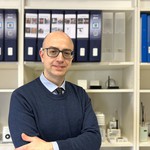Conservator‘s Office
In 2008, the Vatican Museums established a Conservator's Office and ensured the implementation of regular care and maintenance interventions for the vast patrimony of movable works, buildings, archaeological areas, and environments over which they exercise their tutelary functions.
The Conservator's Office is part of the long Vatican maintenance tradition dating back to 1543 when Pope Paul III Farnese created the Office of the Mundator intending to prevent, through periodic de-dusting practices, the accumulation of dust and fumes on the paintings of the Sistine Chapel and other rooms of the Apostolic Palaces. The model of integrated and sustainable global conservation adopted flanks traditional restoration activities with indirect conservation protocols aimed at the collections, the exhibition environment, fittings, and installations, avoiding episodic or disconnected interventions to lower risk profiles, prevent or slow degradation processes and raising the level of quality of the heritage.
A large part of the Office's activity is devoted to monitoring key environmental variables and regularly performing inspections and checks of facilities, which technical reports may follow up with requests for action. The Office then has the task of coordinating the Integrated Maintenance Plan - entrusted to external professional restorers in charge of regular de-polishing, checking and documenting the state of conservation of the works, restoring pictorial decorations, and repairing floors and marble commissions - and the Ordinary Maintenance Plan of the Deposits - which consists of two interventions per year aimed at ensuring cleanliness and overhaul to the Museums' 50-plus storage rooms.
As part of multidisciplinary working groups, the Office collaborates in: the conception of temporary and permanent displays; the design of display cases/windows and travel containers; the experimentation of innovative materials and technical solutions; the study of air conditioning and lighting systems that also take into account conservation issues.
The Office is currently composed of Marco Maggi, Alessandro Barbaresi, and Matteo Mucciante.

Marco Maggi
Head of the Conservator's Office
Marco Maggi, a graduate in "Archaeology, Management, and Enhancement of the Archaeological Heritage" from the University of Genoa, has been on the rolls of the Vatican Museums since 2011, framed within the Office of the Conservator, of which he recently became head.
As of 2009, together with his colleague Alessandro Barbaresi, he has joined the previous head, Dr. Vittoria Cimino, in the various activities of the Office, among which is of primary importance the development of preventive conservation strategies aimed at safeguarding the historical-artistic and archaeological heritage entrusted to the care of the Museums' Management.
Passionate about scientific instrumentation and diagnostic survey techniques, he has been involved in environmental monitoring and analysis of microclimate data and control of natural and artificial illuminance levels and airborne pollutants.
Positions held include collaborations on specialized environmental studies pertaining to the Sistine Chapel, the Vatican Loggias, the Octagonal Courtyard, participation in the scientific secretariat of the international conferences "The Sistine Chapel 20 years later. New breath, new light" (2014), "Preventive conservation in major museums. Comparing strategies" (2018) and "Raphael in the Vatican" (2021), contribution to the editing of volumes published by the Museums and concerning preventive conservation issues.
As for outreach activities, over the years, he has had the opportunity to participate in conventions and conferences with speeches aimed at illustrating the conservation strategy of the Vatican Museums, focusing on the importance of environmental monitoring in understanding the factors of degradation and preventing their occurrence.
Spotlights
Get Involved
Join PAVM and become a contributor the centuries-old artistic patrimony foundational to the Vatican Museums

© 2025 Patrons of the Arts
in the Vatican Museums
Vatican Museums V-00120,
Vatican City State (Europe)
+39 0669864499
